Many trips to Majorca’s Cala Romantica don’t always pan out the way most people would expect, given the name. They tend to begin with a trek over sharp rocks, through scrubland, culminating in a precipitous abseil over a 20 metre cliff that overhangs the turquoise sea. For some that is actually an apt description of love and romance. For us however it was an adventure.
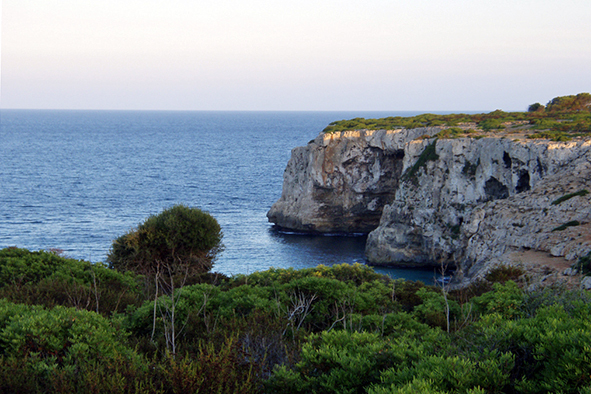
Cala Falco and the cliffs beneath which the sea cave unfolds (Photo: Xisco Ortiz via Flickr)
Few lads holidays to Majorca ever tend to escape the recidivist vortex of self-annihilation that is drinking and hangovers. It is uncommon to be confronted with real fear, unless a large group of fake tanned Brits descending like a terracotta avalanche provokes terror in you. The biggest challenge for most people in Magaluf is working out where to eat: The chippy or the dodgy place selling full English breakfasts all day, where you have to dodge a skin-headed buffoon trying to sell you an hour with an escort just to get a table. You come to expect this. Daily Mail readers love it. And they deserve a place to holiday too; a place where they don’t need to confront the irony that they’re now the foreigner.
For us it was a bit like a day at the zoo. We were somewhat cultured. At least, I like to tell myself that; capable of critical thought and self-control. Hence our need to do something different, to see some of the island, had led us quite literally to this vertiginous cliff edge. What we didn’t expect was that before long we would all have admitted, confronted and overcome certain fears.
Deep Blue
The rope was slipped through my carabiner and I leaned backwards, not being able to see much of what was below. For me the fear of heights was never an issue, it was the sea below that made me nervous. With every crashing wave against jagged rock came an audible reminder that I couldn’t swim. The wind had gotten up and, although the sky was unblemished, the sea swells were enough to double the effort to swim the less than 100 metres to the sea cave.
After dropping the last five metres into the sea I waited as most friends had yet to abseil down. There had been a nervous quiet at the top. Not everybody felt okay with heights and it was the most muted we had been on the trip. Jack* had pressed himself against the rock as far back from the edge as possible. He waited and watched everybody else go before him, plucking up the courage, rationalising his fears. A fear of heights is not the same as a fear of the sea, it churns the stomach.
My own fear was based on the utter unpredictability of the waves and not knowing what lay beneath. As such I was very alert and expending far too much energy in staying afloat. Even in a wet suit, without which I only manage to float a metre or so below the surface, things would have been much harder. I had already swallowed an unhealthy amount of sea water, and the salty taste was beginning to rouse nausea.

View from Cala Romantica with the cave opening in the distance (Photo: Gert Mewes via Flickr)
By the time we had all reached the water I was starting to tire. Jack was visibly relieved and revelled in diving down into the water and bobbing back up some metres away. I have never understood how some people can swim so well, even in big waves. Everybody else sped ahead, but turned back offering great support to me upon realising I was making a complete hash of a simple swim. This support buoyed me. Our guide Tony offered me his bag as a support, but I was determined to do this without assistance. It was mandatory.
We rounded a bluff and steered towards a large cave called Cova de Coloms. The waves slammed into the rocks either side of the opening. I willed my tired arms to keep going and kicked my legs behind me inefficiently, if not doggedly. Before long there were walls either side of me, but much of the physical exertion was spent in not getting dragged back out to the open sea in the backwash, as the receding, post-wave water tugged my helpless form.
With a couple more strokes, another backwash, a few hefty kicks and then the grabbing of a rock protrusion to pull myself along I felt solid ground beneath me; the best thing a weak swimmer could ever hope for. I crawled onto the small sandy beach as the waves broke at a small opening to the cave. I was exhausted. My friends, far less so.
Pitch Black
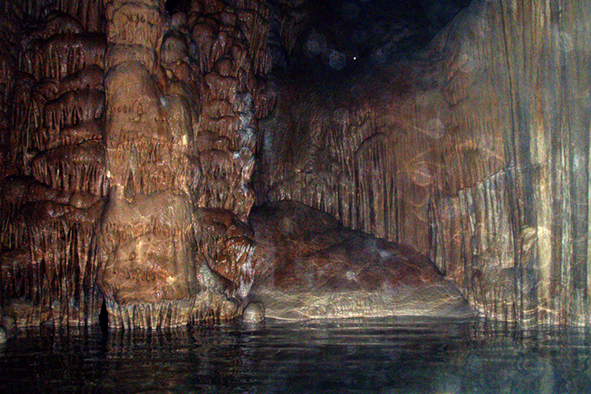
Huge calcium formations in the Cova de Coloms (Photo: Xisco Ortiz via Flickr)
My ordeal was over but for Simon, his was just beginning. We shimmied through a tiny gap in the rock in between waves, to avoid the chance of getting caught and trapped underwater beneath the rock. On the other side a huge cavern opened up like a nether world. The tightness of the cave in places, and the pitch darkness without our headlamps, were two new challenges that tapped into Simon’s subconscious.
With a little light encouragement we pressed on together, deeper into the vast sea cave system of Cova de Coloms. The combination of salt water and normal calcium deposits from water trickling through the limestone creates some remarkable stalactite and stalagmite formations. In places, thick columns had formed that were tens of thousands of years old. In others the stalactites spread out across the ceiling like a system of roots.
We swam through a series of lakes that became less saline the deeper we forayed into the cave. To this point the fear factor was completely surrogated by wonder. Then we left the water and began to climb. The rock was slippery, made more so by the water dripping from our clothes. As we made our way up through a narrow opening, Simon began to feel uneasy. It was my turn to join the chorus of support. I was second from the top. Tony had decided this was a good place to jump into the water below.
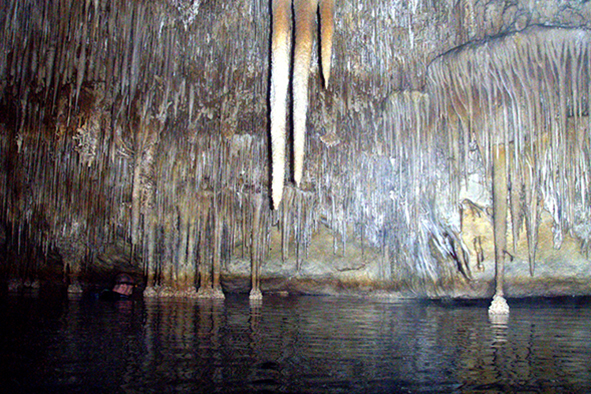
Roof spikes and water (Photo: Xisco Ortiz via Flickr)
“Make sure you jump out as much as possible so you clear this rock sticking out below,” he said, not all that reassuringly.
I tested how much grip I could get from the lip of the drop. It was not looking too safe. I braced, ready to jump, “wait!”
Tony reached over and turned off my headlamp. He then motioned for everybody to do the same. We were plunged into complete darkness. There was not even the faintest whisper of light.
“Don’t worry, it’s only about 10 metres down” said a fell voice in the ink. “Go”
It is one thing to feel weightless when jumping from height. It is another entirely to not know which way is which as you fall. For what felt like some seconds I had no idea if I was falling up or down. I tried not to move too much but felt the water crack hard across my face and ribs. I must have leaned forwards. As I surfaced, there was a light once more way above me. I flapped about until I was out of the way of the next person to jump. Simon was understandably holding back, although the claustrophobia would have to be faced once more if he were to back out and return from whence he’d came.
After another jump he pushed to the front of the queue to get it over and done with. My last sight before all light was extinguished was him balanced precariously. Uncertain. Then I heard a scream, what could only be described as an almighty belly flop, and finally laughter. Another fear conquered, or at least overcome with a little pain to boot.
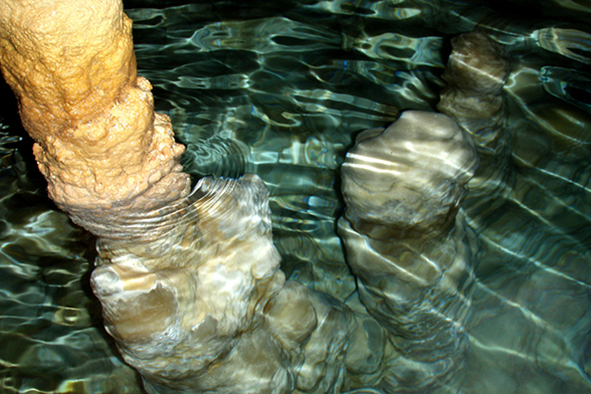
Careful where you step in the Cova de Coloms (Photo: Xisco Ortiz via Flickr)
Towards the Sky
We made our way back out into the sea. Emerging from the cave felt more laborious than before. My limbs were still tired from the first swim. Fortunately this time the swim was somewhat shorter. Just out of the cave’s mouth we hauled ourselves up onto a precipice only licked by the larger waves. This was the final challenge, a climb back up to where we had first started.
Although I had little climbing experience it immediately made sense to me. The idea of climbing up and away from the sea possibly gave me the motivation to enjoy each new foothold, but the idea of being in control was what I really appreciated about the activity. By inches I gained distance from the unpredictable waves by means of a rock face that presented you a full range of options, based on which you could make strong choices in plain daylight. Bill was less enthusiastic about the idea, and even with a rope was not looking forward to the idea. He had been more than comfortable in the waves.
Gaining the top rather rapidly I shouted down some support, but realised concentration would be Bill’s key ally once on the wall. By inches he made his way up, clearly not enjoying this process of being just a tiny mistake away from a fall.
It may not have been the toughest series of activities we’ll ever face, but the experience had drawn out different fears in each one of us. Something about sharing that experience, even if you don’t share the same fear, was far more bonding than another round of shots. For everything Majorca is infamous for, it is this remarkable side to the island’s nature and topography that has come to define the island for me now.
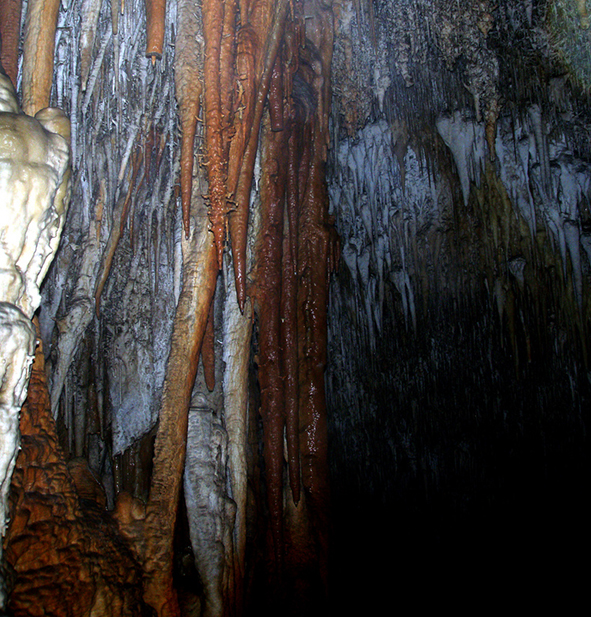
Red and white stalactites (Photo: Xisco Ortiz via Flickr)
*Some names have been changed to maintain anonymity.